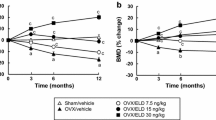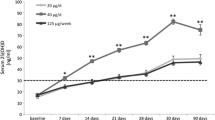Abstract
Although there is abundant evidence from animal studies that 1,25-dihydroxychole-calciferol [1,25-(OH)2D3] is synthesized in the kidney, it is still unknown whether human bone might also be involved in the formation of this metabolite. To investigate whether 1,25-(OH)2D3 can be synthesized by human bone, 25-hydroxycholecalciferol (25-OH D3) metabolism was assessed in vitro by incubation with human trabecular bone. The bone tissue, obtained from the femoral heads of 34 patients undergoing hip replacement surgery, was ground and thoroughly cleaned of blood and bone marrow. Five hundred mg of spongiosa were incubated with (3H)-25-OH D3 at a concentration of 1.67 nM in 2 ml Eagle’s minimum essential medium. The metabolites formed were separated either by LH 20 column chromatography followed by high performance liquid chromatography (HPLC) or by HPLC alone and the elution profiles compared to either commercially available or biologically synthesized tritiated 1,25-(OH)2D3 and 24,25-(OH)2D3. The formation of a metabolite which was chromatographically similar to 1,25-(OH)2D3 was observed in 15, and a metabolite with the chromatographic features of 24,25-(OH)2D3 in 13 of 21 bone samples. In 4 samples an additional metabolite more polar than 1,25-(OH)2D3 was observed. I n 6 bone samples no chromatographic evidence for the production of any metabolite of 25-OH D3 could be found. Ten per cent isopropanol, 1 ml of uremic serum or replacement of NADPH by NADH in the incubation medium completely suppressed the production of all derivatives. The demonstration that human bone is able to metabolize 25-OH D3 may be important for the understanding of bone physiology.
Similar content being viewed by others
References
Blunt J.W., DeLuca H.F., Schnoes H.K. 25-hydroxycholecalciferol. A biologically active metabolite of vitamin D3. Biochemistry 7: 3317, 1968.
Holick M.F., Schnoes H.K., DeLuca H.F., Gray R.W., Boyle T.T., Suda T. Isolation and identification of 24,25-dihydroxycholecalciferol, a metabolite of vitamin D made in the kidney. Biochemistry 11: 4251, 1972.
Fraser D.R., Kodicek E. Unique biosynthesis by kidney of a biologically active vitamin D metabolite. Nature (London) 228: 764, 1970.
Kleiner A., DeLuca H.F. Formation of 1,24,25-trihydroxy-vitamin D3 from 1,25-dihydroxyvitamin D3. Biochem. Biophys. Acta 338: 489, 1974.
Wong R.G. The role of calciferol (vitamin D) and its biologically active metabolite, 1,25-dihydroxycholecalciferol, in the metabolism of calcium. Ph. D. Dissertation, University of California, 1972.
Malluche H.H., Meyer-Sabellek W., Massry S.G., Henry H., Norman A.W. Effects and interaction of 1,25-(OH)2D3 and 24,25-(OH)2D3 on bone. In: Norman A.W., Schäfer K., v. Herrath D., Grigoleit H.-G., Coburn J.W., DeLuca H.F., Mawer E.B., Suda T. (Eds.), Vitamin D. Basic research and its clinical application. Walter de Gruyter, Berlin, New York, 1979, p. 425.
Lambert P.W., Syverson B.I., Arnaud C.D., Spelsberg T.C. Isolation and quantitation of endogenous vitamin D and its physiologically important metabolites in human plasma by high pressure liquid chromatography. J. Steroid Biochem. 8: 929, 1977.
Keck E., Durdel R., Schweickert H.U., Krück F., Krüs-kemper H.L. Metabolism of 25-hydroxycholecalciferol in human bone. Horm. Metab. Res. 13:417, 1981.
Howard G.A., Turner R.T., Sherrad D.J., Baylink D.J. Human bone cells produce 1,25-(OH)2D3 and 24,25-(OH)2D3. Clin. Res. 29, 1:54 A, 1981.
Howard G.A., Turner R.T., Sherrad D.J., Baylink D.J. Human bone cells in culture metabolize 25-hydroxyvi-tamin D3 to 1,25-dihydroxyvitamin D3 and 24,25-dihy-droxyvitamin D3. J. Biol. Chem. 256: 7738, 1981.
Ghazarian J.G., DeLuca H.F. 25-hydroxycholecalciferol-I-hydroxylase: a specific requirement for NADPH and a hemoprotein component in chick kidney mitochondria. Arch. Biochem. Biophys. 160: 63, 1974.
Chen Th.L., Hirst M.A., Feldman D. A receptor-like binding macromolecule for 1,25-dihydroxycholecalciferol in cultured mouse bone cells. J. Biol. Chem. 254: 7691, 1979.
Schweikert H.U., Rulf W., Niederle N., Schäfer H.E., Keck E., Krück F. Testosterone metabolism in human bone. Acta Endocrinol. (Kbh.) 95: 258, 1980.
Garabedian M., Lieberherr M., Corvol M.T., Guillozo H., Thil C.L., Balsan S. Cellular location and regulation of the 24,25-dihydroxyvitamin D3 formation in cultured cells from bone and cartilage. In: Norman A.W., Schäfer K., v. Herrath D., Grigoleit H.-G., Coburn J.W., DeLuca H.F., Mawer E.B., Suda T. (Eds.), Vitamin D — Basic research and its clinical application. Walter de Gruyter, Berlin, New York, 1979, p. 391.
Kumar R., Schnoes H.K., DeLuca H.F. Rat intestinal 25-hydroxyvitamin D3-and l-alpha, 25-hy-droxyvitamin D3-24-hydroxylase. J. Biol. Chem. 253: 3804, 1978.
Author information
Authors and Affiliations
Rights and permissions
About this article
Cite this article
Keck, E., Durdel, R., West, T. et al. Metabolism of 25-hydroxycholecalciferol by human bone. J Endocrinol Invest 6, 211–216 (1983). https://doi.org/10.1007/BF03350610
Received:
Accepted:
Published:
Issue Date:
DOI: https://doi.org/10.1007/BF03350610




